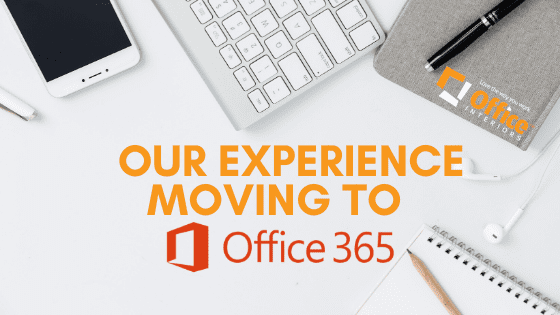Where we were before Microsoft 365
At Office Interiors, we had hosted Exchange server on-premise with maintenance support by our IT provider. In total we had 100 Microsoft Outlook and Microsoft Office suite users, using a variety of versions (2003, 2007, 2013).
We found our hosted Exchange became more unreliable and problematic, leading to, on average, between 20 to 25 email and Outlook related IT support tickets every month.
Relying on an on-premise hosted Exchange server also meant that when our office with the server lost power, all 100 of our staff lost access to their email, shared drives and ability to work from other offices, their homes or on the road.
What it was costing us
We were incurring significant costs to maintain this on-premise solution, including:
- Between $4000 and $4500 per month ($48,000 to $54,000 per year) IT services for support tickets, upgrades and updates
- $3000 annually for Anti-Spam software
- $200 per month ($2400 per year) for backup services provided by our IT provider for email (using Vault)
- $39 per month ($468 per year) for GoToMeeting to use as our collaboration and video conferencing tool
- Hardware and software upgrade every three years to maintain our server and Microsoft compliance (approximately $15,000 to $20,000 every three years)
- Buying volume Microsoft licenses to ensure compliance with Microsoft licensing
In total, hosting our own Exchange server was costing us in excess of $53,800 every single year before accounting for the amount that we had to spend on hardware and software upgrades every three years.
Our Migration to M365 (the cloud)
We migrated all 100 users from our on-premise Exchange solution to Microsoft 365 (65 to M365 Premium and 35 to M365 Essentials). Our IT partner was able to support this migration with a 3rd party migration tool called SkyKick. The entire migration took only seven days (4 days of setup and configuration, 3 days of migration activities).
In addition to the base M365 Essentials and Premium packages, we chose to implement Microsoft 365 Advanced Threat Protection for additional spam email security and M365 Mail Back-up for the mailboxes of 30 critical users.
Where we are with Microsoft 365
As a result of our migration to the cloud, all of our M365 email and Microsoft Office suite licenses are kept compliant, our applications up to date with the latest version (2016) and we now have fewer than five IT support tickets related to email each month.
By utilizing M365 we have full access to email, shared drives, and critical files in the case of a power outage or on the road.
How much we are saving
We have also noticed significant cost savings after the migration. Our IT support and maintenance costs have decreased to approximately $2000 to $3000 per month, a savings of $1500 to $2000 every month ($18,000 to $24,000 per year).
We have also been able to reduce our costs for spam security and mail backup for critical mailboxes by implementing Advanced Threat Protection and Mail Back-up to save $500 and $1800, respectively, each year.
Implementing Microsoft Teams as our collaboration and video conferencing of choice allowed us to cancel GoToMeeting and save an additional $39 monthly ($468 per year).
Arguably most significantly, we no longer have any hardware or software that will need to be replaced or upgraded every three years.
Overall, we have found that our move to M365 is saving us more than $25,800 annually.
Other opportunities created by M365 that we are implementing
In addition to migrating our Outlook and Office suite to the cloud, moving to M365 has created a variety of other opportunities we are currently working on:
- Utilizing Microsoft SharePoint and One Drive to store key files that can then be accessed anywhere, even without a connection to the Office Interiors network.
- Using Microsoft Power Apps and SharePoint to create an automated and paperless expense form submission process.
- Deploying Microsoft Bookings to streamline scheduling meetings both internally and with external customers and vendors.
- Building an Employee Directory with Microsoft Power Apps
- Moving our HR Policy Manuals to a dedicated SharePoint site so that all employees have access to the most up to date versions, even from home or on the road.
- Deploying Microsoft OneNote for note-taking and collaboration.



